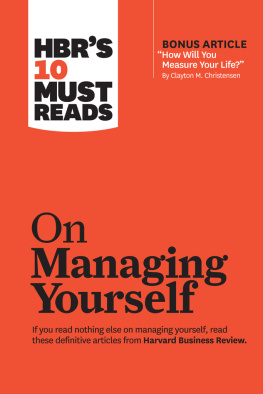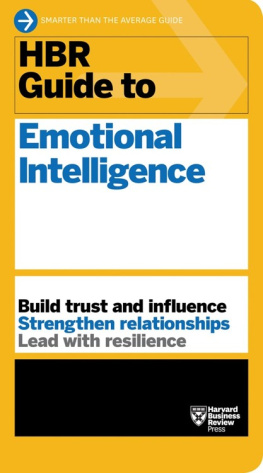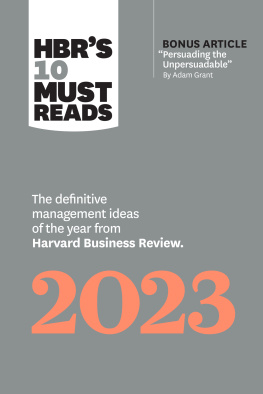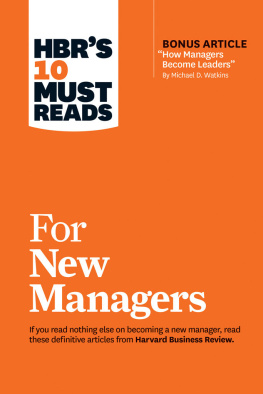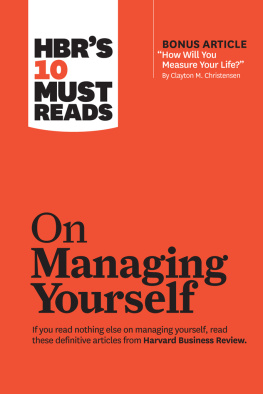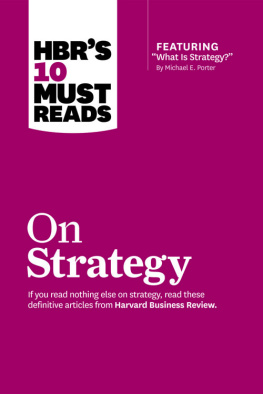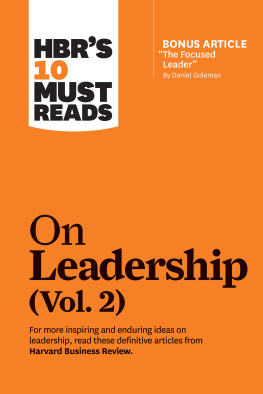Contents
Once youve got a solid foundation with HBRs Must Reads, check out the Complete HBR On... Series to dig more deeply into the specific areas that matter most to you. Explore the best practices and ideas on communicating effectively, collaborating, making smart decisions, and many more topics.
Copyright 2011 Harvard Business School Publishing Corporation
All rights reserved
No part of this publication may be reproduced, stored in or introduced into a retrieval system, or transmitted, in any form, or by any means (electronic, mechanical, photocopying, recording, or otherwise), without the prior permission of the publisher. Requests for permission should be directed to , or mailed to Permissions, Harvard Business School Publishing, 60 Harvard Way, Boston, Massachusetts 02163.
First eBook Edition: November 2010
ISBN: 978-1-4221-3344-6
Contents
Clayton M. Christensen and Michael Overdorf
Thomas H. Davenport
Peter F. Drucker
Daniel Goleman
Robert S. Kaplan and David P. Norton
Rosabeth Moss Kanter
John P. Kotter
Theodore Levitt
Michael E. Porter
C.K. Prahalad and Gary Hamel
by Clayton M. Christensen and Michael Overdorf
THESE ARE SCARY TIMES for managers in big companies. Even before the Internet and globalization, their track record for dealing with major, disruptive change was not good. Out of hundreds of department stores, for example, only oneDayton Hudsonbecame a leader in discount retailing. Not one of the minicomputer companies succeeded in the personal computer business. Medical and business schools are strugglingand failingto change their curricula fast enough to train the types of doctors and managers their markets need. The list could go on.
Its not that managers in big companies cant see disruptive changes coming. Usually they can. Nor do they lack resources to confront them. Most big companies have talented managers and specialists, strong product portfolios, first-rate technological know-how, and deep pockets. What managers lack is a habit of thinking about their organizations capabilities as carefully as they think about individual peoples capabilities.
One of the hallmarks of a great manager is the ability to identify the right person for the right job and to train employees to succeed at the jobs theyre given. But unfortunately, most managers assume that if each person working on a project is well matched to the job, then the organization in which they work will be, too. Often that is not the case. One could put two sets of identically capable people to work in different organizations, and what they accomplished would be significantly different. Thats because organizations themselvesindependent of the people and other resources in themhave capabilities. To succeed consistently, good managers need to be skilled not just in assessing people but also in assessing the abilities and disabilities of their organization as a whole.
This article offers managers a framework to help them understand what their organizations are capable of accomplishing. It will show them how their companys disabilities become more sharply defined even as its core capabilities grow. It will give them a way to recognize different kinds of change and make appropriate organizational responses to the opportunities that arise from each. And it will offer some bottom-line advice that runs counter to much thats assumed in our can-do business culture: if an organization faces major changea disruptive innovation, perhapsthe worst possible approach may be to make drastic adjustments to the existing organization. In trying to transform an enterprise, managers can destroy the very capabilities that sustain it.
Before rushing into the breach, managers must understand precisely what types of change the existing organization is capable and incapable of handling. To help them do that, well first take a systematic look at how to recognize a companys core capabilities on an organizational level and then examine how those capabilities migrate as companies grow and mature.
Where Capabilities Reside
Our research suggests that three factors affect what an organization can and cannot do: its resources, its processes, and its values. When thinking about what sorts of innovations their organization will be able to embrace, managers need to assess how each of these factors might affect their organizations capacity to change.
Idea in Brief
Why do so few established companies innovate successfully? Of hundreds of department stores, for instance, only Dayton Hudson became a discount-retailing leader. And not one minicomputer company succeeded in the personal-computer business.
Whats going on? After all, most established firms boast deep pockets and talented people. But when a new venture captures their imagination, they get their people working on it within organizational structures (such as functional teams) designed to surmount old challengesnot ones that the new venture is facing.
To avoid this mistake, ask:
Does my organization have the right resources to support this innovation? Resources supporting business-as-usualpeople, technologies, product designs, brands, customer and supplier relationshipsrarely match those required for new ventures.
Does my organization have the right processes to innovate? Processes supporting your established business decision-making protocols, coordination patternsmay hamstring your new venture.
Does my organization have the right values to innovate? Consider how you decide whether to commit to a new venture. For example, can you tolerate lower profit margins than your established enterprise demands?
What team and structure will best support our innovation effort? Should you use a team dedicated to the project within your company? Create a separate spin-off organization?
By selecting the right team and organizational structure for your innovationand infusing it with the right resources, processes, and valuesyou heighten your chances of innovating successfully.
Idea in Practice
| Selecting the Right Structure for Your Innovation |
| If your innovation... | Select this type of team... | To operate... | Because... |
| Fits well with your existing values and processes | Functional teams who work sequentially on issues, or lightweight teamsad hoc cross-functional teams who work simultaneously on multiple issues | Within your existing organization | Owing to the good fit with existing processes and values, no new capabilities or organizational structures are called for. |
| Fits well with existing values but poorly with existing processes | Heavyweight team dedicated exclusively to the innovation project, with complete responsibility for its success | Within your existing organization | The poor fit with existing processes requires new types of coordination among groups and individuals. |
| Fits poorly with existing values but well with existing processes | Heavyweight team dedicated exclusively to the innovation project, with complete responsibility for its success |




